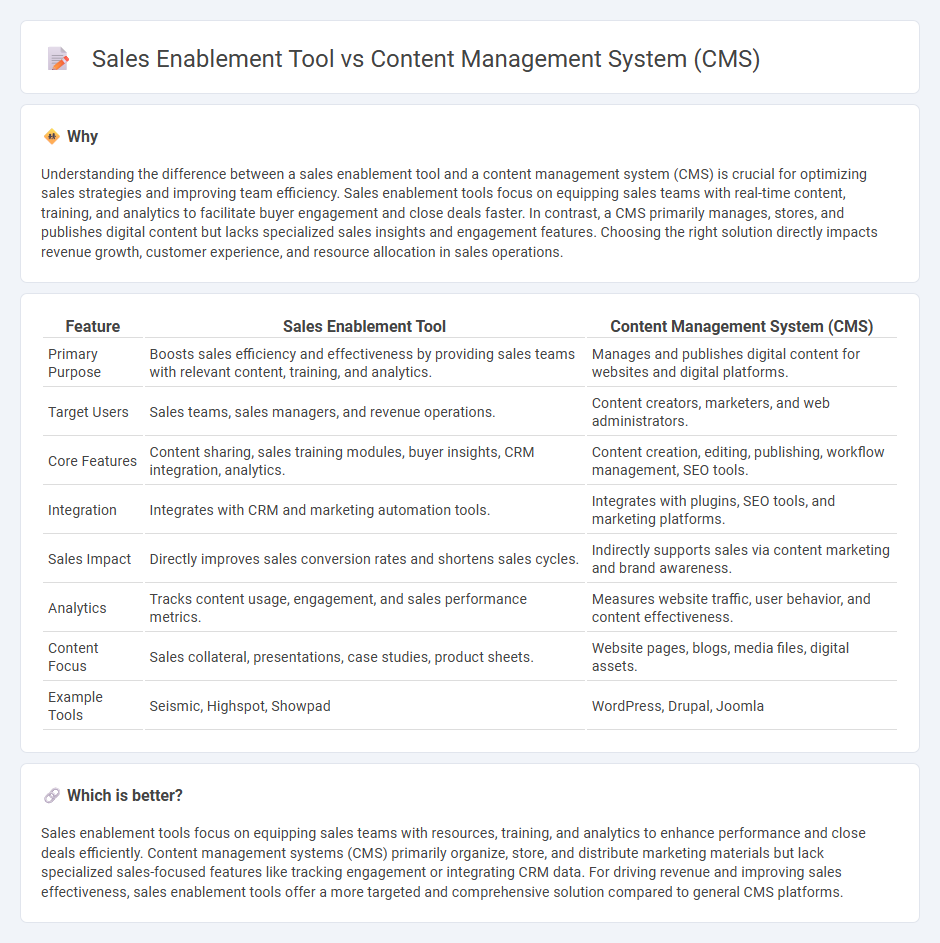
Sales enablement tools streamline the sales process by providing reps with targeted resources, training, and analytics to engage prospects effectively. Content management systems (CMS) focus on organizing and delivering digital content but lack the specialized features to directly support sales activities and buyer interactions. Explore the differences between these platforms to optimize your sales strategy and resource utilization.
Why it is important
Understanding the difference between a sales enablement tool and a content management system (CMS) is crucial for optimizing sales strategies and improving team efficiency. Sales enablement tools focus on equipping sales teams with real-time content, training, and analytics to facilitate buyer engagement and close deals faster. In contrast, a CMS primarily manages, stores, and publishes digital content but lacks specialized sales insights and engagement features. Choosing the right solution directly impacts revenue growth, customer experience, and resource allocation in sales operations.
Comparison Table
| Feature | Sales Enablement Tool | Content Management System (CMS) |
|---|---|---|
| Primary Purpose | Boosts sales efficiency and effectiveness by providing sales teams with relevant content, training, and analytics. | Manages and publishes digital content for websites and digital platforms. |
| Target Users | Sales teams, sales managers, and revenue operations. | Content creators, marketers, and web administrators. |
| Core Features | Content sharing, sales training modules, buyer insights, CRM integration, analytics. | Content creation, editing, publishing, workflow management, SEO tools. |
| Integration | Integrates with CRM and marketing automation tools. | Integrates with plugins, SEO tools, and marketing platforms. |
| Sales Impact | Directly improves sales conversion rates and shortens sales cycles. | Indirectly supports sales via content marketing and brand awareness. |
| Analytics | Tracks content usage, engagement, and sales performance metrics. | Measures website traffic, user behavior, and content effectiveness. |
| Content Focus | Sales collateral, presentations, case studies, product sheets. | Website pages, blogs, media files, digital assets. |
| Example Tools | Seismic, Highspot, Showpad | WordPress, Drupal, Joomla |
Which is better?
Sales enablement tools focus on equipping sales teams with resources, training, and analytics to enhance performance and close deals efficiently. Content management systems (CMS) primarily organize, store, and distribute marketing materials but lack specialized sales-focused features like tracking engagement or integrating CRM data. For driving revenue and improving sales effectiveness, sales enablement tools offer a more targeted and comprehensive solution compared to general CMS platforms.
Connection
Sales enablement tools and content management systems (CMS) are interconnected by streamlining access to marketing collateral, product information, and sales content, which enhances sales team efficiency and consistency. CMS platforms organize and update content centrally, while sales enablement tools deliver this content contextually during the buyer's journey, driving higher engagement and conversion rates. This integration ensures real-time content delivery, analytics tracking, and seamless collaboration, optimizing sales performance and customer experience.
Key Terms
Lead Nurturing
A Content Management System (CMS) streamlines the organization and delivery of marketing content, ensuring consistent messaging throughout the buyer's journey, which supports lead nurturing by providing relevant resources at each stage. Sales enablement tools enhance this process by equipping sales teams with real-time insights, personalized content, and automated follow-ups that directly engage and convert leads more effectively. Explore the key differences and benefits of CMS and sales enablement tools to optimize your lead nurturing strategy.
Asset Personalization
Asset personalization in a content management system (CMS) allows for streamlined content creation and dynamic updates tailored to target audiences, enhancing overall user engagement. Sales enablement tools specialize in customizing sales collateral and training materials to meet specific customer needs, thereby accelerating the sales cycle and improving conversion rates. Discover how optimizing asset personalization through these platforms can boost team efficiency and drive revenue growth.
Performance Analytics
Performance analytics in content management systems (CMS) primarily track content engagement metrics such as page views, time on page, and user behavior patterns to optimize content strategies. Sales enablement tools offer deeper performance analytics focused on sales activities, measuring metrics like content usage during sales cycles, lead conversion rates, and sales rep effectiveness. Explore further to understand how each platform's analytics can enhance your business outcomes.
Source and External Links
What is a content management system (CMS)? - A content management system is software that allows users to create, manage, and edit digital content easily without coding, supporting collaborative workflows, digital asset management, and multi-channel content delivery.
Content management system - A CMS manages the creation and modification of digital content and typically includes a content management application (for editing) and content delivery application (for publishing), available as on-premises or cloud-based platforms.
What Is A Content Management System (CMS)? - A CMS helps teams create, organize, and publish content via user-friendly interfaces, featuring role-based permissions and separating the front end (display) from the back end (content input and storage).
 dowidth.com
dowidth.com